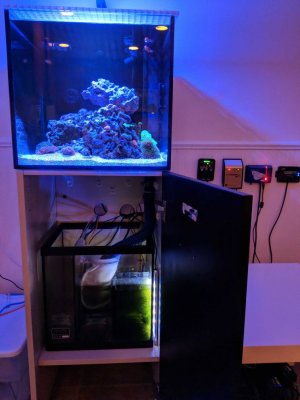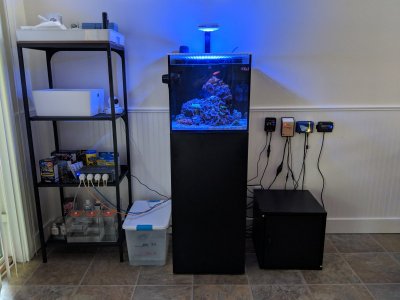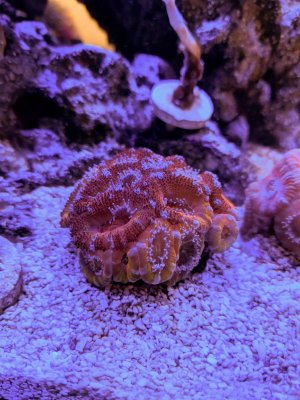Navigation
Install the app
How to install the app on iOS
Follow along with the video below to see how to install our site as a web app on your home screen.
Note: This feature may not be available in some browsers.
More options
You are using an out of date browser. It may not display this or other websites correctly.
You should upgrade or use an alternative browser.
You should upgrade or use an alternative browser.
Acan colony dying
- Thread starter pomoev
- Start date
- Tagged users None
- Joined
- Oct 20, 2018
- Messages
- 62
- Reaction score
- 20
I'm not sure if it's mold, fungus or bacteria, but this is something that grows really fast. 3 days ago when I noticed it, only one polyp was affected, and I thought it might by simply stung by the hammerhead.
But the next day a few new polyps got covered with this white stuff and now it's almost 1/3 of the colony. I'm afraid 2-3 more days and the coral is going to be dead.
Isn't it how pretty much every medicine works?
Fragging sounds like a reasonable idea if no medication works, but I have never fragged an LPS. I only have a dremel rotary tool with a diamond wheel, i'm afraid it's too tough.
No sterilizer.
I added a couple photos of my setup. A month ago I added a skimmer to the system and raised the light a little higher over the tank.


And a photo of the acan as of month ago.

I'd recommend the uv. It's good to protect your investment. Many problems will disappear, avoided.
It looks a lot better! Feeders are out. Do you have any mysis? If you can get some proper nutrients into that colony you should see some dramatic recovery.Ok, just checked it, no white slime, the unaffected polyps feel good. I hope the morning iodine bath helped.
Sweet! Just watch it closely if bacteria starts growing on it again just keep dipping it until the infection is goneOk, just checked it, no white slime, the unaffected polyps feel good. I hope the morning iodine bath helped.
- Joined
- Oct 20, 2018
- Messages
- 62
- Reaction score
- 20
Sweet! Just watch it closely if bacteria starts growing on it again just keep dipping it until the infection is gone
If their is bacteria, dipping it would make it worse. God help that colony. Good luck. Read some scholarly articles. That scan I just a survivor through your troture.
Lots of conflicting information here. Glad to see the acan seems to have recovered somewhat. I'd suggest leaving it be and keeping a close eye on it for the next few weeks. If it was simply stung by the hammer coral and your tank parameters are stable and in range, you should expect a full recovery. Good luck.
That is not exactly true, this Bacterial infection(commonly referred as Brown jelly disease) is a common problem. The infected tissue is usually done for but if you Dip the corals in Iodine or something similar you can stop the spread and the coral can start growing and heal. If left be the infection will slowly overtake an kill the coral. Infections usually start from damage to the coral, I've had to deal with it multiple times because my frogspawn coral sometimes sends off little polyps (even had one start a new coral) and they will land on a coral sting it and cause an infection to start. Here is an article I found! http://aquariumcoraldiseases.weebly.com/brown-jelly-syndrome-bjs--brown-band-disease-brb.html. This article is sort but it even brings up the fact that the bacteria might only be present because of the dying tissue and something else is killing the coral.If their is bacteria, dipping it would make it worse. God help that colony. Good luck. Read some scholarly articles. That scan I just a survivor through your troture.
- Joined
- Feb 28, 2017
- Messages
- 128
- Reaction score
- 46
Postmortem: the coral died in less than a week after my last message. I noticed that iodine dip kind of slowed down the speed of tissue necrosis for 12-24 hours. If I didn't give it a dip for a day I found a few new dead polyps. In ~5 days I gave up.
All the acans that were sitting around that one are healthy and look good.
How to avoid this situation in the future:
All the acans that were sitting around that one are healthy and look good.
How to avoid this situation in the future:
- have a quarantine tank ready,
- have something other than iodine (Coral RX, peroxide?) handy,
- act immediately after noticing the first sick polyp.
- Joined
- Oct 20, 2018
- Messages
- 62
- Reaction score
- 20
It also stated can't spread to healthy coral. Stress makes coral unhealthy. If you steralize the coral and replace it in an unsteral environment your chances of contracting bacteria rise. If there is bacteria treat your tank. Iodine kills good and bad bacteria. Study your article.That is not exactly true, this Bacterial infection(commonly referred as Brown jelly disease) is a common problem. The infected tissue is usually done for but if you Dip the corals in Iodine or something similar you can stop the spread and the coral can start growing and heal. If left be the infection will slowly overtake an kill the coral. Infections usually start from damage to the coral, I've had to deal with it multiple times because my frogspawn coral sometimes sends off little polyps (even had one start a new coral) and they will land on a coral sting it and cause an infection to start. Here is an article I found! http://aquariumcoraldiseases.weebly.com/brown-jelly-syndrome-bjs--brown-band-disease-brb.html. This article is sort but it even brings up the fact that the bacteria might only be present because of the dying tissue and something else is killing the coral.
That is not exactly true, this Bacterial infection(commonly referred as Brown jelly disease) is a common problem. The infected tissue is usually done for but if you Dip the corals in Iodine or something similar you can stop the spread and the coral can start growing and heal. If left be the infection will slowly overtake an kill the coral. Infections usually start from damage to the coral, I've had to deal with it multiple times because my frogspawn coral sometimes sends off little polyps (even had one start a new coral) and they will land on a coral sting it and cause an infection to start. Here is an article I found! http://aquariumcoraldiseases.weebly.com/brown-jelly-syndrome-bjs--brown-band-disease-brb.html. This article is sort but it even brings up the fact that the bacteria might only be present because of the dying tissue and something else is killing the coral.
Whats happening to this acan(or rather did) and Brown Jelly are 2 totally different things. Yes BJD is a bacterial infection, but it is in no way a white cottony mass. It literally looks like brown jelly ontop of the coral. I've had it, and there is no known cure for it other then fragging the dead heads from the coral. Even then that does not necessarily stop the infection. I lost 2 torch's, 4 hammers, 2 octospawn, and 2 frogspawn to BJD, I'm pretty sure I know what it looks like, and did massive research on how to stop it.
Read your own posted article. BJD does not resemble a white cottony mass.
Whats happening to this acan(or rather did) and Brown Jelly are 2 totally different things. Yes BJD is a bacterial infection, but it is in no way a white cottony mass. It literally looks like brown jelly ontop of the coral. I've had it, and there is no known cure for it other then fragging the dead heads from the coral. Even then that does not necessarily stop the infection. I lost 2 torch's, 4 hammers, 2 octospawn, and 2 frogspawn to BJD, I'm pretty sure I know what it looks like, and did massive research on how to stop it.
Read your own posted article. BJD does not resemble a white cottony mass.
Ive had brown jelly multiple times in my tank, and you are right it does look brown. Ive also experienced brown jelly where it was dark brown and light brown. Brown jelly is kinda a blanket statement when it comes to infections. There are many different types of strands and infections, an example with human infections would be a staff infection. There are many different types of staff infections and can look way different depending on the exact strain, where the infection is, and many other elements. I think that that was a bacterial infection. Also not to be rude I did read my own article. I am sorry that you weren't able to fight off the infection in your tank sometimes it can be really hard to stop it once it starts.
It also stated can't spread to healthy coral. Stress makes coral unhealthy. If you steralize the coral and replace it in an unsteral environment your chances of contracting bacteria rise. If there is bacteria treat your tank. Iodine kills good and bad bacteria. Study your article.
Once again I did read my own article where it even states a common way to fight it is with iodine. If in close proximity healthy tissue will get infected. If you can stop it with a dip of some sort then you can save the coral. You can also use broad-spectrum antibiotic as stated in that article. There is tons of bacteria in a tank and the idea is to kill the bacteria that is killing the coral and it is possible. I'm not trying to argue but want to share that it isn't impossible to stop these types of infections and I have been successful in the past.
- Joined
- Oct 20, 2018
- Messages
- 62
- Reaction score
- 20
Ive had brown jelly multiple times in my tank, and you are right it does look brown. Ive also experienced brown jelly where it was dark brown and light brown. Brown jelly is kinda a blanket statement when it comes to infections. There are many different types of strands and infections, an example with human infections would be a staff infection. There are many different types of staff infections and can look way different depending on the exact strain, where the infection is, and many other elements. I think that that was a bacterial infection. Also not to be rude I did read my own article. I am sorry that you weren't able to fight off the infection in your tank sometimes it can be really hard to stop it once it starts.
Once again I did read my own article where it even states a common way to fight it is with iodine. If in close proximity healthy tissue will get infected. If you can stop it with a dip of some sort then you can save the coral. You can also use broad-spectrum antibiotic as stated in that article. There is tons of bacteria in a tank and the idea is to kill the bacteria that is killing the coral and it is possible. I'm not trying to argue but want to share that it isn't impossible to stop these types of infections and I have been successful in
From reading what you wrote, that means you need to dose antibiotics.
- Joined
- Oct 20, 2018
- Messages
- 62
- Reaction score
- 20
Kill the bacteria in the tank.Ive had brown jelly multiple times in my tank, and you are right it does look brown. Ive also experienced brown jelly where it was dark brown and light brown. Brown jelly is kinda a blanket statement when it comes to infections. There are many different types of strands and infections, an example with human infections would be a staff infection. There are many different types of staff infections and can look way different depending on the exact strain, where the infection is, and many other elements. I think that that was a bacterial infection. Also not to be rude I did read my own article. I am sorry that you weren't able to fight off the infection in your tank sometimes it can be really hard to stop it once it starts.
Once again I did read my own article where it even states a common way to fight it is with iodine. If in close proximity healthy tissue will get infected. If you can stop it with a dip of some sort then you can save the coral. You can also use broad-spectrum antibiotic as stated in that article. There is tons of bacteria in a tank and the idea is to kill the bacteria that is killing the coral and it is possible. I'm not trying to argue but want to share that it isn't impossible to stop these types of infections and I have been successful in the past.
Similar threads
- Replies
- 77
- Views
- 1,820
- Replies
- 3
- Views
- 137
- Replies
- 1
- Views
- 224
- Replies
- 2
- Views
- 108
















